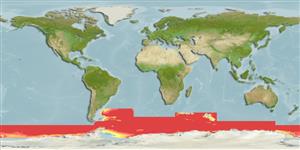>
Myctophiformes (Lanternfishes) >
Myctophidae (Lanternfishes) > Gymnoscopelinae
Etymology: Gymnoscopelus: Greek, gymnos = naked + Greek, skopelos, a lantern fish (Ref. 45335).
Environment: milieu / climate zone / depth range / distribution range
Écologie
marin bathypélagique; océanodrome (Ref. 51243); profondeur 550 - 900 m (Ref. 58018). Deep-water; 40°S - 75°S
Circumpolar south of Antarctic Polar Front, but absent from the southern and central regions of Ross and Weddell seas and extending to 40°S in Falkland Current region.
Taille / Poids / Âge
Maturity: Lm ? range ? - ? cm
Max length : 16.2 cm SL mâle / non sexé; (Ref. 5182)
Épines dorsales (Total) : 0; Rayons mous dorsaux (Total) : 15 - 18; Épines anales: 0; Rayons mous anaux: 16 - 18.
Oceanic and bathypelagic (Ref. 4066). Adults found usually deeper than 500 m, but larvae and juveniles in 66 to 200 m at temperatures of -0.18°C to 6.23°C.
Life cycle and mating behavior
Maturities | Reproduction | Spawnings | Egg(s) | Fecundities | Larves
Hulley, P.A., 1990. Myctophidae. p. 146-178. In O. Gon and P.C. Heemstra (eds.) Fishes of the Southern Ocean. J.L.B. Smith Institute of Ichthyology, Grahamstown, South Africa. (Ref. 5182)
Statut dans la liste rouge de l'IUCN (Ref. 130435)
Menace pour l'homme
Harmless
Utilisations par l'homme
Outils
Articles particuliers
Télécharger en XML
Sources Internet
Estimates based on models
Preferred temperature (Ref.
123201): -0.2 - 1, mean 0.5 °C (based on 72 cells).
Phylogenetic diversity index (Ref.
82804): PD
50 = 0.5039 [Uniqueness, from 0.5 = low to 2.0 = high].
Bayesian length-weight: a=0.00437 (0.00199 - 0.00957), b=3.16 (2.96 - 3.36), in cm total length, based on LWR estimates for this (Sub)family-body shape (Ref.
93245).
Niveau trophique (Ref.
69278): 3.3 ±0.40 se; based on food items.
Résilience (Ref.
120179): Milieu, temps minimum de doublement de population : 1,4 à 4,4 années (Preliminary K or Fecundity.).
Fishing Vulnerability (Ref.
59153): Low vulnerability (10 of 100).
